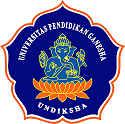PENGARUH MODEL PEMBELAJARAN BERBASIS PROYEK TERHADAP KEMAMPUAN BERPIKIR KREATIF DAN KINERJA ILMIAH SISWA
Abstract
ABSTRAK
Marlinda, Ni Luh Putu Mery Marlinda. 2012. Pengaruh Model Pembelajaran Berbasis Proyek Terhadap Kemampuan Berpikir Kreatif dan Kinerja Ilmiah Siswa. Tesis. Program Studi Pendidikan IPA Program Pascasarjana Universitas Pendidikan Ganesha.
Tesis ini sudah dikoreksi dan disetujui oleh Pembimbing I: Prof. Dr. I Wayan Sadia, M. Pd., dan Pembimbing II: Prof. Dr. I Wayan Suastra, M. Pd.
Kata kunci: model pembelajaran berbasis proyek (MPjBL), model pembelajaran konvensional (MPK), kemampuan berpikir kreatif, dan kinerja ilmiah.
Tujuan penelitian ini adalah untuk menganalisis perbedaan: (1) kemampuan berpikir kreatif dan kinerja ilmiah antara kelompok siswa yang belajar dengan MPjBL dan kelompok siswa yang belajar dengan MPK, (2) kemampuan berpikir kreatif antara kelompok siswa yang belajar dengan MPjBL dan kelompok siswa yang belajar dengan MPK, dan (3) kinerja ilmiah antara kelompok siswa yang belajar dengan MPjBL dan kelompok siswa yang belajar dengan MPK. Fokus masalah penelitian ini adalah pengaruh model pembelajaran pembelajaran berbasis proyyek terhadap kemampuan berpikir kreatif dan kinerja ilmiah siswa.
Penelitian ini menggunakan desain eksperimen non-equivalent post-test only control group design. Populasi dalam penelitian ini adalah seluruh siswa pada kelas VII SMP Dwijendara Denpasar tahun pelajaran 2011/2012 yang terdiri atas 225 siswa. Pengambilan sampel penelitian berdasarkan teknik random sampling. Data yang diperoleh, kemudian dianalisis dengan statistik deskriptif dan MANOVA one-way. Sebagai tindak lanjut dari MANOVA one-way, maka digunakan Least Significant Difference (LSD) untuk menguji signifikansi perbedaan skor rata-rata tiap kelompok perlakuan.
Hasil penelitian menunjukkan, terdapat perbedaan kemampuan berpikir kreatif dan kinerja ilmiah antara kelompok siswa yang belajar dengan MPjBL dan kelompok siswa yang belajar dengan MPK (F = 21,68; p<0,05). Secara deskriptif, kemampuan berpikir kreatif siswa pada kelompok MPjBL memperoleh skor rata-rata sebesar 28,86, sedangkan pada kelompok MPK memperoleh skor rata-rata sebesar 26,73. Kemudian, skor rata-rata kinerja ilmiah yang diperoleh siswa pada kelompok MPjBL adalah 21,96, sedangkan siswa pada kelompok MPK memperoleh skor rata-rata sebesar 19,49. Kedua, terdapat perbedaan kemampuan berpikir kreatif antara kelompok siswa yang belajar dengan MPjBL dan kelompok siswa yang belajar dengan MPK (F = 16,58; p<0,05) dengan LSD = 0,519; Δμ = 2,128. Ketiga, terdapat perbedaan kinerja ilmiah antara kelompok siswa yang belajar dengan MPjBL dan kelompok siswa yang belajar dengan MPK (F = 28,87; p<0,05) dengan LSD = 0,897; Δμ = 2,475.
ABSTRACT
Marlinda, Ni Luh Putu Marlinda Mery. 2012. The Effect of Project-based Learning Model on Creative Thinking Ability and Students’ Scientific Performance. Thesis. Science Education Study Program, Post-graduate Program of Ganesha University of Education.
This thesis has been corrected and approved by the Supervisor I: Prof. Dr. I Wayan Sadia, M. Pd., and Supervisor II: Prof. Dr. I Wayan Suastra, M. Pd.
Keywords: project-based learning model (MPjBL), conventional learning model (MPK), the ability to think creatively, and scientific performance.
The purpose of this study was to analyze the differences of: (1) creative thinking skills and scientific performance between groups of students who studied using MPjBL and groups of students who learnt using MPK, (2) the ability of creative thinking among the students who studied using MPjBL and groups of students who studied using MPK, and (3) scientific performance between groups of students who studied using MPjBL and groups of students who learnt using MPK. The focus of this research problem is the influence of the learning model of learning based on the ability to think creatively and the science performance of students.
This study uses experimental design of non-equivalent post-test only control group design. The population in this study were seventh grade students of Dwijendra Junior High School, Denpasar in the academic year 2011/2012 consisting of 225 students. The sample was taken using random sampling techniques. The data obtained were then analyzed using descriptive statistics and one-way MANOVA. As the follow-up of one-way MANOVA, Least Significant Difference (LSD) was used to test the significance of differences of the average scores of each treatment group.
The result of the analyses shows that: there are differences in the ability to think creatively and science performance among groups of students who studied with MPjBL and groups of students who studied with the MPK (F = 21.68, p <0.05). Descriptively, the creative thinking of students in the group of MPjBL obtain the average score of 28.86, while, the creative thinking of students in the group of MPK obtain the average score of 26.73. Further, the scientific performance of students in the group of MPjBL obtain the average score of 21.96, while, the scientific performance of students in the group of MPK obtain the average score of 19.49. Second, there is a difference in creative thinking between groups of students who studied with MPjBL and groups of students who learnt using MPK (F = 16.58, p <0.05) by LSD = 0.519; Δμ = 2.128. Third, there is a difference in scientific performance between groups of students who studied using MPjBL and groups of students who learnt using MPK (F = 28.87, p <0.05) by LSD = 0.897; Δμ = 2.475.
Full Text:
PDFRefbacks
- There are currently no refbacks.
Jurnal ini diterbitkan oleh :
Universitas Pendidikan Ganesha
Jurnal Pendidikan dan Pembelajaran IPA Indonesia is licensed under a Creative Commons Attribution-ShareAlike 4.0 International License.
Jurnal Pendidikan dan Pembelajaran IPA Indonesia indexed by:





Jurnal Pendidikan dan Pembelajaran IPA Indonesia is licensed under a Creative Commons Attribution-ShareAlike 4.0 International License.








